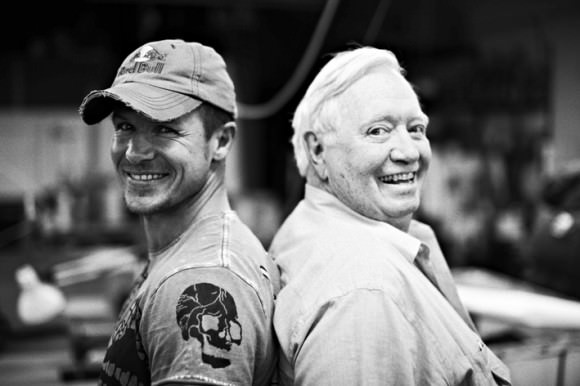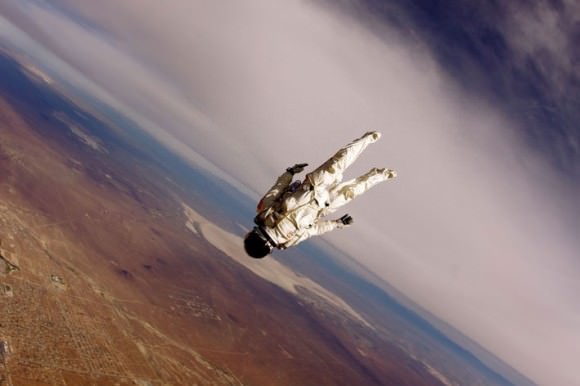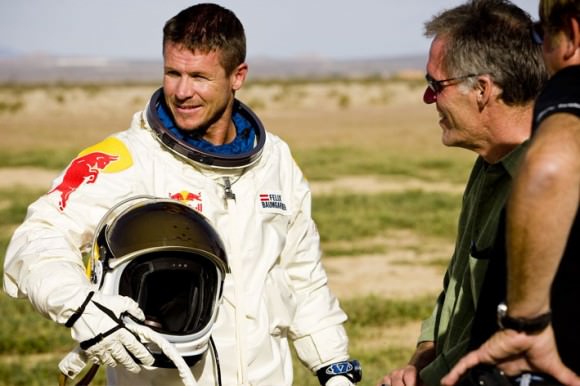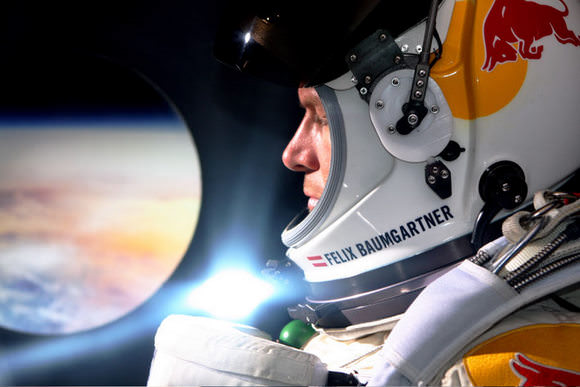[/caption]
The speed of sound — historically called the ‘sound barrier’ – has been broken by rockets, various jet-powered aircraft and rocket-boosted land vehicles. Felix Baumgartner wants to break the sound barrier with his body, in freefall from the edge of space. He will travel inside a capsule with a stratospheric balloon to 36,500 meters (120,000 feet) step out and attempt a freefall jump targeted to reach – for the first time in history – supersonic speeds.
“After years of training with my team of dedicated Red Bull Stratos experts, I’ll be going on a journey that no one has ever done,” Baumgartner told Universe Today in an email message. “If I succeed, I will be the first person to break the sound barrier, alone. That will be a record for all eternity. As such, a piece of me will become immortal. That excites me.”

Back in 1960, a US Air Force captain named Joe Kittinger made aerospace history by making a jump from 31,000 meters (102,800 feet). His jump contributed valuable data that provided ground work for spacesuit technology and knowledge about human physiology for the US space program. There have been several attempts to surpass Kittinger’s record, but none have succeeded, and people have given their lives for the quest.
Sometime during 2010, Baumgartner will make an attempt in his “Red Bull Stratos” mission — named after the energy drink company that co-created the program with the Austrian skydiver. Red Bull Stratos team members say the mission will explore the limits of the human body in one of the most hostile environments known to humankind, in the attempt to deliver valuable lessons in human endurance and high-altitude technology.
“This is the biggest goal I can dream of,” Baumgartner said. “If we can prove that you can break the speed of sound and stay alive I think that is a benefit for future space exploration.”
If Baumgartner is successful, the Red Bull Stratos mission will break four world records: the altitude record for freefall, the distance record for longest freefall, the speed record for fastest freefall by breaking the speed of sound with the human body, and the altitude record for the highest manned balloon flight.

How fast will Baumgarter need to go to beat the speed of sound? Sound travels at different speeds through the atmosphere (as well as through different mediums), depending on atmospheric density and temperature. For example, at sea level, in average conditions of about 15 degrees C (59 degrees F), sound travels at around 1,223 kph (760 mph). But at higher altitudes, where the air is colder, sound travels more slowly.
Researchers with the Red Bull Stratos mission anticipate Baumgartner could break the sound barrier at about 30,480 meters (100,000 feet) above sea level, in temperatures of -23 to -40 C (-10 to -40 F) where sound travels at about 1,110 kph (690 mph) or roughly 304 meters per second (1,000 feet per second).
So, he’ll have to go faster than those speeds – or Mach 1 — to be supersonic.
While there is no literal “barrier,”the transition to supersonic speeds can cause problems for aircraft as transonic air movement creates disruptive shock waves and turbulence. Data obtained from Chuck Yeager’s first supersonic flight in 1947 allowed for changes in design of supersonic aircraft to avoid problems. Still, some aircraft still experience problems, and going supersonic has been attributed to some air disasters.
And the human body isn’t designed for supersonic speeds.
“Our biggest concern is that we don’t know how a human unencumbered by aircraft is going to transition through this,” said the project’s Medical Director Dr. Jonathan Clark, a flight surgeon for six space shuttle missions (and husband of astronaut Laurel Clark who died in the Columbia disaster in 2003), who has researched numerous aerospace disasters. “But it’s also exactly what we’re hoping to learn, for the benefit of future space flights.”
Documents provided by the Red Bull Stratos mission say that the data obtained from the mission will be shared with the scientific community, and Clark notes that he expects long-awaited medical protocols to be established as a result.
At the low temperatures and tenuous atmospheric conditions that Baumgartner will experience, he could suffer from hypothermia, the bends –if he gains altitude too fast during ascent –, or he could experience ebullism – the infamous condition where gas bubbles can form in the blood, and the blood basically “boils.”

That’s why his spacesuit is so important.
“I have absolute confidence the suit is going to work,” said Daniel McCarter, Program Manager for the David Clark Company, the same company that made Kittinger’s suit back in 1960, as well as full pressure suits for NASA astronauts and military pilots flying in aircraft that can reach the edge of the atmosphere. “Every time someone jumps a suit system like this there is something to learn. We learn knowledge for future systems.”
Art Thompson, the mission’s Technical Project Director, added, “We are ultimately risking life. Felix realizes that his life is on the line. Our job is to do everything we can from an engineering and technical point of view to keep him safe.”
The suit Baumgartner will use is custom-made for him, so there should be no pressure points caused by the suit that would make him uncomfortable, but any pressure suit restricts mobility and dexterity. He will have to avoid movements that could cause him to go into an uncontrollable spin.
Baumgartner is not new to jumping. He owns several world records for B.A.S.E. jumping and is well known for skydiving across the English Channel in 2003. He is also a parachutist, stunt coordinator and a commercial helicopter pilot.
“I think I’ve always been one of those guys who wanted to be in the places where no one has been before. It’s inside your body or brain,” Baumgartner said in a video on the Red Bull Stratos website. “When I was a kid, I liked to climb up trees –I always wanted to be on top of something.”
This will definitely be an attempt to go where no one has gone before.
For more information on the mission, visit the Red Bull Stratos website, or Felix Baumgartner’s website.


A more suitable title would be “Skydiver is nuts and attempts to do nutty things”, methinks…
‘As such, a piece of me will become immortal.’
Unfortunately, this is most probably what is going to happen.
A heady adventure at the ultimate edge of the World.
They missed a bit he would be the 2nd to exceed speed of sound
Colonel Joe Kittinger
On August 16, 1960, he set three world records: the highest parachute jump (102,800 feet), the longest parachute free fall (4 minutes 36 seconds), and the first person to exceed the speed of sound without an aircraft or space vehicle (714 mph during free fall)
Scottie,
According to Wikipedia “On August 16, 1960, he made the final jump from the Excelsior III at 102,800 feet (31,300 m).[1] Towing a small drogue chute for initial stabilization, he fell for four minutes and 36 seconds, reaching a maximum speed of 614 mph [2][3] (988 km/h or 274 m/s) before opening his parachute at 18,000 feet (5,500 m). Pressurization for his right glove malfunctioned during the ascent, and his right hand swelled up to twice its normal size.[4][5] He set historical numbers for highest balloon ascent, highest parachute jump, longest drogue-fall (four minutes), and fastest speed by a human being through the atmosphere[6]. These are still current USAF records, but were not submitted for aerospace world records to the Fédération Aéronautique Internationale (FAI).” ( http://en.wikipedia.org/wiki/Joe_Kittenger )
Is your figure of 714 mph a typo or, if not, what is your source?
This has got to be the most ridiculous nonsense possible. Pure Evik K’nevil (sp) sort of stunt IMO. What purpose does this serve? What can be possibly learned, I mean real information, from this?
LC
Best of luck. I had a micrometeorite collecting package on the Qinetic Balloon that failed to leave the deck of the boat complete with two pilots a few years ago.
Success is not certain.
And they say there is no more adventure to be had on our so explored Earth. (Minus the oceans, the crust, and the core, of course!)
And I’m sure excited about the exploration of the envelope of what bodies can do.
My reactions to the post:
– Having “absolute confidence the suit is going to work” (which functions?) and experiencing that “there is something to learn” is in empirical conflict. The facts is likely as Clark stated, we don’t know how a human body transitions to supersonic speed. (And it is damn hard to figure out without actually doing at least a dummy transition.)
– It took a few moments to puzzle out what “kph” stands for. Over in the metric world we mostly seem to use “km/h” as a measure of speed analogous to SI measures km/s or m/s.
My reactions to the commentaries:
– It has always been the case that speed transitions have been seen as dangerous. (Traveling faster than speeding horses in open trains, traveling in free fall when parachuting, traveling faster than supersonic speed in planes, traveling faster than supersonic speed in cars, et cetera.)
And it has always been the case that the concerns are overblown. Speed doesn’t kill you as such; it’s the acceleration or jerk (acceleration of acceleration) that does.
But as speed records goes, this is indeed risky.
– It’s a stunt, but there will be unique knowledge gained (see above). Any of those are enough to do it, the combination is a win-win!
Oh, and since his is a fact related blog: it is href=”http://en.wikipedia.org/wiki/Evel_Knievel”>Evel Knievel, artist name of Robert Craig Knievel.
[LOL when typing: even my browser spell checker knew that one. Icons are icons.]
Ah, come on, LC.
If you only could you would be the first one to try it.
http://en.wikipedia.org/wiki/Felix_Baumgartner
In 2003, Baumgartner became the first person to cross the English Channel in freefall using a specially made fibre wing. This device was further developed since and today it is known as Gryphon.
Wiki: The Gryphon is a military wingsuit that currently allows paratroopers to exit an aircraft at an altitude of 10 kilometres, then fly 40 kilometres while carrying up to 100 kilograms of equipment. The system is still in development and the goal, according to ESG, is to allow paratroopers to fly up to 200 kilometres, thus enabling them to penetrate enemy airspace without compromising the safety of the aircraft or being detected by radar.
http://en.wikipedia.org/wiki/Gryphon_(parachute_system)
Consideration:
Some are against human activity in space and call it nonsense. One question is: where will they draw the line? Obviously, to them already supersonic freefall is contemptible.
If progress in this direction continues, one time in the future humans will dive into the atmosphere from orbit.
“then with a slow incline
of his broad breast
like to a diver
in the pearly seas
forward he stoop’d
over the airy shore
and plung’d all noiseless
into the deep night ”
John Keats, Hyperion
“And the human body isn’t designed for supersonic speeds.”
What does this mean?
Astronauts during a space walk flies about 28.000 km/h. Astronauts during Apollo did also EVA so probably even faster than 28.000 km/h depending wher they did the EVA.
Speed itself has no influence on the human.
@rudeyd
If you had the chance to have the kick of your life would you not do everything to try it?
Okay, suppose he breaks the sound barrier and doesn’t injure himself in the fall or tumble out of control, the next logical question is: how is he going to stop? How does he slow down from Mach 1 without shredding his chute? And, how does the chute deploy without harming him as it pulls out of his pack so quickly? I’m sure they’ve taken these questions into consideration, but a little explanation on these issues would have been equally as important to us readers. Guess it’s irrelevant: as long as he breaks the records, he will eventually come to a stop–WHAM! SPLAT!